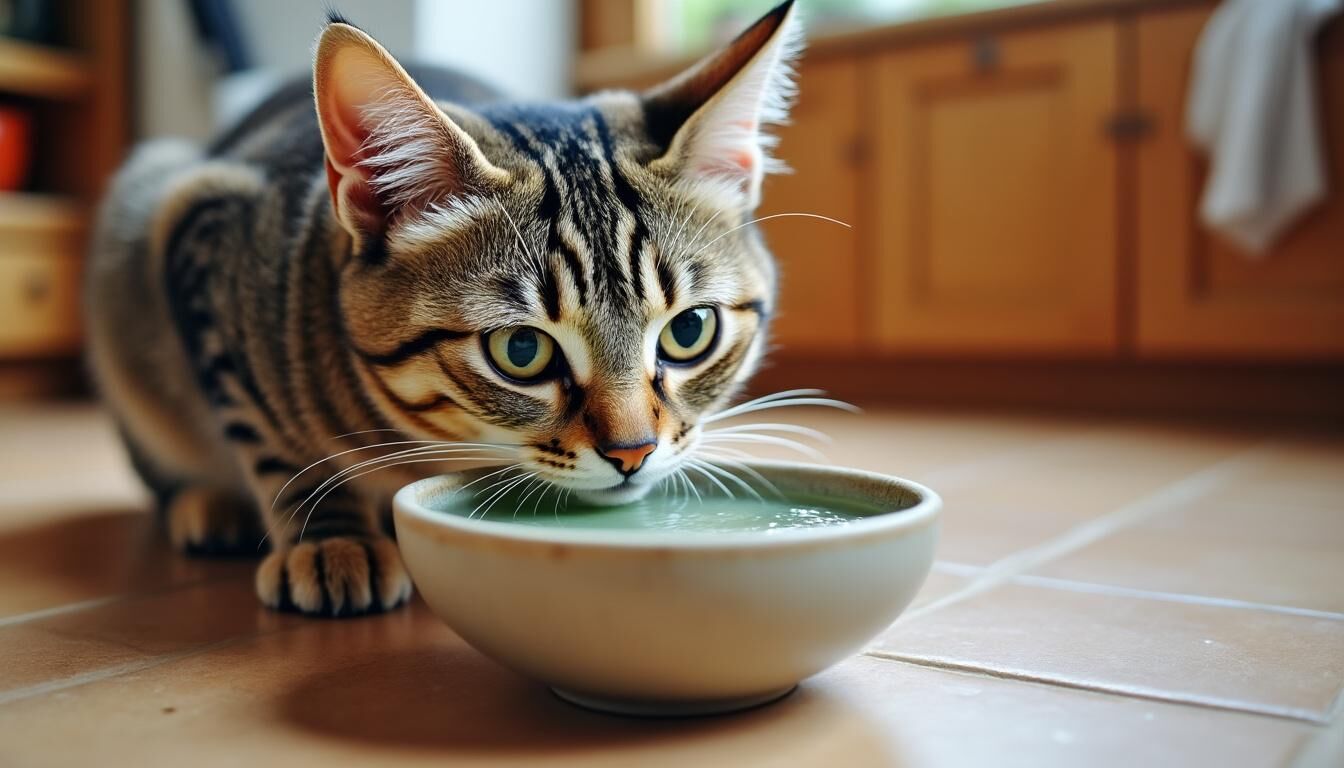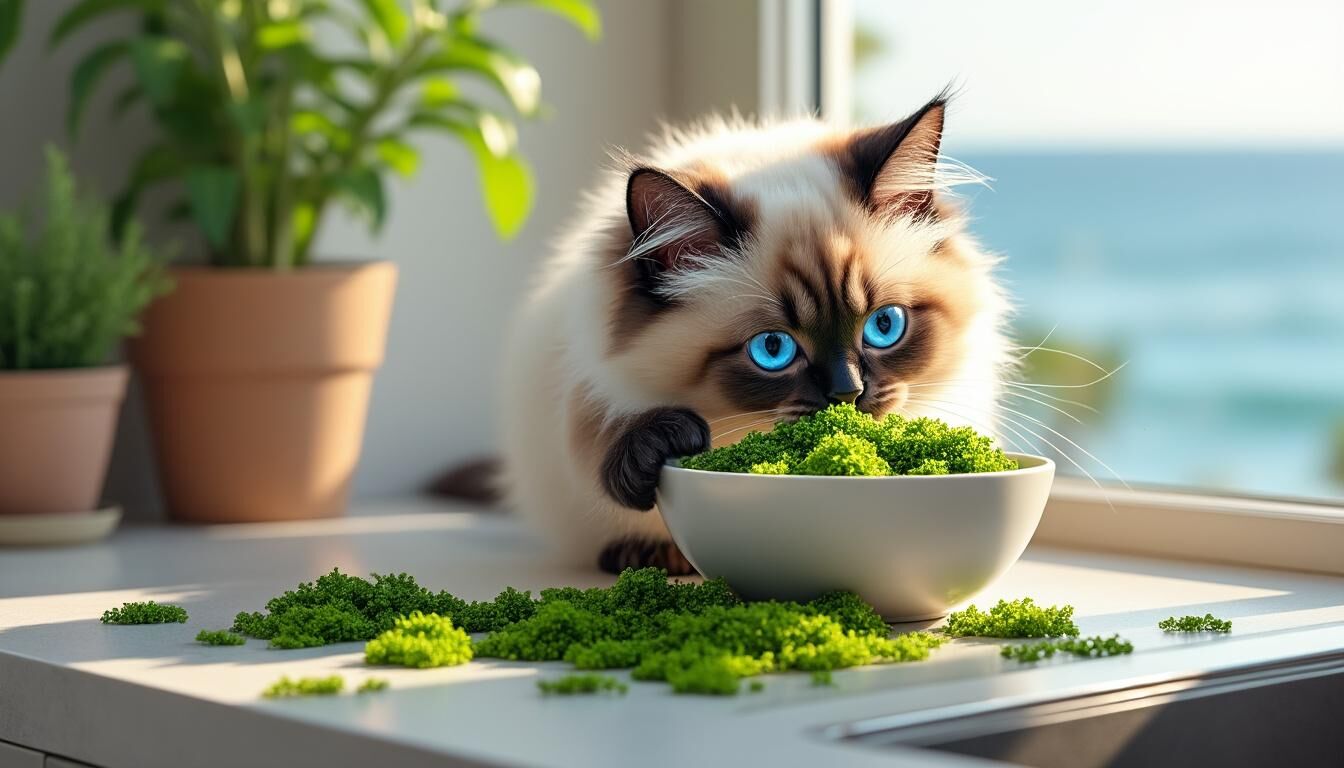Sea moss, also known scientifically as Chondrus crispus or more commonly as Irish moss, has surged in popularity as a natural supplement rich in nutrients and antioxidants. It has a deep-rooted history in human health remedies, boasting a unique combination of vitamins (A, C, E, and K) and essential minerals like iodine, calcium, iron, magnesium, and potassium. While humans enthusiastically incorporate sea moss into their diets, pet owners—particularly cat parents—are increasingly curious about its potential role in feline health. But what about cats? Do they naturally gravitate towards sea moss, and more importantly, is it safe and beneficial for their complex dietary requirements? This article critically examines sea moss from the perspective of cat nutrition, exploring its prospects as a supplement for these obligate carnivores that often prefer specific tastes and textures.
The conversation begins with an overview of what sea moss actually is, delving into its nutrient-rich profile and why it commands the attention of wellness communities. Following this, it considers the unique physiological and behavioral aspects of cats that impact their acceptance or rejection of sea moss. Cat enthusiasts and veterinarians alike seek clarity on whether sea moss poses any risks, especially concerning iodine content and potential allergies, plus how to responsibly introduce it into a feline diet. Finally, the piece reflects on scientific evidence, anecdotal reports, and expert guidelines concerning sea moss’s role in supporting skin, coat, digestion, and immune function, along with suitable alternatives and purchase advice. In short, it offers a layered but accessible exploration, balancing curiosity with caution for optimal pet welfare.
What Is Sea Moss and Why Is It Considered for Cats?
Sea Moss (Irish Moss): Nutrients and Antioxidants Explained
Sea moss, or Irish moss, is a type of red algae traditionally harvested from the rocky coasts of the North Atlantic. Its scientific name, Chondrus crispus, denotes its crinkly, fan-like fronds rich in bioactive compounds. This marine plant is celebrated for its dense nutritional value, offering a spectrum of vitamins and minerals critical for maintaining bodily functions.
Key components found in sea moss include:
-
🔹 Iodine: Supports thyroid function, crucial for metabolism regulation.
-
🔹 Calcium and magnesium: Important for bone strength and muscle function.
-
🔹 Iron: Vital for oxygen transportation in the blood.
-
🔹 Potassium: Regulates fluid balance and nerve signals.
-
🔹 Vitamins A, C, E, and K: Antioxidants that protect cells and support immune health.
Besides these, sea moss contains natural antioxidants known for their anti-inflammatory and immune-boosting properties. Its polysaccharides act as prebiotics, fostering gut flora balance in humans.
|
Component 🧪 |
Role in Health 🌿 |
Typical Amount in Sea Moss per 100g ⚖️ |
|---|---|---|
|
Iodine |
Thyroid hormone synthesis and metabolism regulation |
50-60 mcg (varies with source) |
|
Calcium |
Bone mineralization and muscle contraction |
70-100 mg |
|
Iron |
Oxygen transport in blood |
3-8 mg |
|
Vitamin C |
Immune system support and antioxidant action |
2-4 mg |
Sea Moss as a Supplement: Human Health Versus Pet Use
Sea moss’s rise as a natural health supplement in human diets stems from its versatility — used in smoothies, gels, and topical remedies. It is praised for supporting thyroid balance, skin elasticity, joint comfort, and gut health.
When it comes to pets, especially cats, sea moss is viewed more cautiously. Unlike humans with omnivorous tendencies, cats have unique physiology and diet requirements. While some pet owners introduce sea moss for its antioxidants and minerals, veterinarians emphasize moderation and monitoring because cats do not naturally consume seaweed or algae. The benefits seen in humans do not always translate directly to felines given their obligate carnivore status.
-
🐱 Human use: Regular supplementation, cosmetic uses, immune and thyroid support.
-
🐾 Cat use: Occasional, cautious supplementation targeted at specific needs.
-
⚖️ Monitoring: Essential when given to cats due to unique metabolism.
-
⛔ Not a diet staple: Should not replace meat-based nutrition fundamental for cats.
Do Cats Like Sea Moss? Feline Curiosity, Taste Preferences, and Eating Habits
Obligate Carnivores: Unique Dietary Needs of Cats
Cats are obligate carnivores, which means their diet must be meat-based to supply essential amino acids like taurine, and specific vitamins they cannot synthesize. Plant matter, including seaweed or algae, is not a natural component of their wild or domestic eating habits. Their digestive systems are adapted to process proteins and fats rather than plant fibers.
Accordingly, cats generally exhibit selective eating behaviors shaped by these biological needs. Texture, smell, and past experiences with foods influence their acceptance or rejection of new ingredients such as sea moss.
-
🍖 High protein, low carbohydrate dietary requirement.
-
👅 Sensory sensitivity influencing taste and texture preferences.
-
🐾 Natural instincts favoring meat over plant matter.
-
🧠 Repeated exposure may increase acceptance but varies widely.
Typical Cat Reactions to Sea Moss: Interest or Rejection?
Introducing sea moss to cats often results in a spectrum of responses. Some cats display curiosity especially if sea moss is mixed into wet food or favored treats, while many outright reject it.
Texture plays a substantial role. The gelatinous or slightly slimy consistency of sea moss can be unfamiliar and off-putting to cats accustomed to firm meat textures. Anecdotal reports from cat owners on platforms like Facebook reveal that although some cats will lick or nibble small amounts of sea moss gel, few voluntarily seek it out.
-
🤨 Curiosity is common initially but not always sustained.
-
👎 Possible rejection due to unfamiliar texture or flavor.
-
👍 Some cats accept it when blended with preferred foods.
-
🕵️♀️ Individual differences highlight the importance of observation.
Is Sea Moss Safe for Cats? Iodine, Allergies, and Veterinary Guidelines
Potential Side Effects: Digestive Upset, Allergic Reactions, and More
While sea moss generally appears safe in small quantities for cats, caution is necessary due to specific components such as iodine. Excessive iodine intake may disrupt thyroid function, which is vital for a cat’s metabolic regulation. Cats with pre-existing thyroid issues, such as hyperthyroidism, may be particularly vulnerable.
Other possible risks include digestive disturbances, like vomiting or diarrhea, especially if sea moss is introduced abruptly or in large amounts. Allergic reactions, although rare, may manifest as skin irritation, itching, or respiratory symptoms. Ongoing veterinary observation is crucial to ensure safety.
-
⚠️ High iodine levels may cause thyroid imbalance.
-
🤢 Digestive upset including vomiting or diarrhea.
-
🛑 Allergic reactions requiring immediate veterinary care.
-
📋 Importance of veterinary supervision.
Consulting Your Vet Before Adding Sea Moss to Cat Diets
Prior to incorporating sea moss, cat owners should seek advice from a qualified veterinarian, particularly for cats with health conditions affecting the thyroid or those on medications. This consultation ensures individualized risk assessment, appropriate dosing, and careful monitoring. Veterinarians can also recommend safe sourcing to avoid heavy metal or contaminant exposure associated with some seaweed products.
Cat parents should weigh the benefits against the potential risks and confirm that sea moss supplementation complements rather than replaces a balanced, meat-focused diet.
Potential Benefits of Sea Moss for Cats: Fact, Anecdote, and Science
Skin, Coat, and Immune Support: Nutritional Highlights
The rich array of vitamins and minerals in sea moss, especially vitamins A and E, can enhance skin and coat quality in cats. These nutrients have antioxidant properties that help protect skin cells from oxidative stress and support the immune system. Anecdotal evidence from pet owners often reports shinier coats and reduced skin dryness after careful supplementation.
Nevertheless, these observations are primarily derived from user experience rather than extensive scientific trials tailored to feline physiology.
-
✨ Vitamins A and E promote healthy skin and fur.
-
🛡️ Antioxidants support immune function.
-
💧 Mineral content aids hydration of the skin.
-
📖 Anecdotal benefits require cautious interpretation.
Fiber and Digestive Health from Sea Moss in Feline Diets
Sea moss contains soluble fiber and prebiotics that may assist with digestion by regulating bowel movements and supporting beneficial gut bacteria. For cats prone to constipation or mild gastrointestinal upset, small amounts of sea moss could theoretically improve digestive health.
However, since feline gastrointestinal systems do not naturally rely on plant fibers, excess sea moss may cause more harm than good if not carefully dosed.
Why Scientific Evidence for Cats Is Still Limited
Research on sea moss’s effects on cats remains in its infancy. Most existing studies focus on human subjects or other animals, with few peer-reviewed clinical trials addressing feline responses. This scarcity limits firm conclusions about either prolonged safety or the full scope of benefits.
Thus, while nutritional theory supports potential advantages from its ingredients, empirical data is needed, and anecdotal reports should guide but not dictate usage.
How to Safely Introduce Sea Moss to Cats, Risks, Alternatives, and Expert Advice
Gradual Introduction: Dosage, Preparation, and Monitoring Your Cat
Introducing sea moss to cats should be a slow and measured process. Begin with tiny doses (a pea-sized amount mixed into wet food) to test tolerance. Ideal preparations involve freshly soaked, thoroughly rinsed sea moss from organic, additive-free sources.
During the trial phase, closely observe for any changes in appetite, stool quality, energy levels, or signs of allergic reaction. If any negative symptoms arise, discontinue immediately and consult a veterinarian.
-
🥄 Start with very small doses.
-
🧼 Use pure, organic sea moss with no preservatives.
-
👁️ Monitor cat behavior and health carefully.
-
🍽️ Avoid replacing main meals with sea moss.
Common Risks: Iodine Toxicity, Allergies, and Interactions
Excessive iodine intake from sea moss poses the largest risk for cats, potentially leading to thyroid dysfunction. Allergic reactions, while infrequent, may also occur. Additionally, interactions with medications or existing conditions require vigilance.
Cat owners should be aware of symptoms like lethargy, excessive thirst, vomiting, diarrhea, itching, or changes in fur quality as early warning signs prompting veterinary evaluation.
Alternatives to Sea Moss: Cat Grass, Fish Oil, Pumpkin, and Bone Broth
For those hesitant about sea moss or seeking safer options, several natural supplements support similar aspects of feline health:
-
🌾 Cat grass: Enhances digestion and provides roughage.
-
🐟 Fish oil: Rich in omega-3 fatty acids for skin, coat, and joint health.
-
🎃 Pumpkin: A gentle source of fiber aiding bowel regularity.
-
🥣 Bone broth: Hydrates and promotes immune and joint function.
Veterinary Insights: Balanced Diets, Supplementation, and Myths
Veterinary professionals generally endorse a well-balanced, meat-centric diet as the cornerstone of feline nutrition. Where supplements like sea moss are considered, they emphasize cautious use guided by evidence and the cat’s individual health profile. Myths such as “all cats dislike sea moss,” “sea moss is unsafe,” or “cats cannot digest seaweed” lack nuanced understanding and overlook the variation in individual preferences and tolerability.
Approaching supplementation with informed moderation aligns best with ensuring long-term well-being.
Choosing High-Quality Sea Moss Products for Pet Safety
Quality selection is paramount. Opt for sea moss sourced from pristine environments, certified organic and sustainably harvested, without fillers, chemicals, or artificial preservatives. Proper handling involves soaking and rinsing sea moss thoroughly to remove sand and potential contaminants, preserving beneficial nutrients.
Always store sea moss in a cool, dry place and check product labels for purity. This vigilance maximizes safety and ensures cats receive the intended benefits without inadvertent exposure to toxins.
|
Quality Factor 🧐 |
Importance for Cats 🐱 |
Selection Tips ✔️ |
|---|---|---|
|
Organic Certification |
Minimizes pesticide and contaminant risk |
Look for USDA Organic or reputable third-party labels |
|
Sustainable Harvesting |
Ensures healthy marine ecosystems and clean sources |
Choose brands practicing sustainable collection methods |
|
No Additives or Fillers |
Prevents exposure to harmful chemicals |
Read ingredient lists carefully for purity |
|
Preparation Instructions |
Reduces contamination risks and optimizes nutrient retention |
Follow soaking, rinsing, and storage guidelines strictly |

FAQ
-
Q: Can all cats safely eat sea moss?
A: Most cats can tolerate small amounts, but those with thyroid issues or allergies should avoid it or seek veterinary approval first. -
Q: How much sea moss is safe to give a cat?
A: Start with pea-sized portions once or twice a week; it should never replace regular meals. -
Q: What signs indicate a cat is not tolerating sea moss?
A: Vomiting, diarrhea, lethargy, excessive thirst, or skin irritation are red flags necessitating immediate discontinuation. -
Q: Are sea moss supplements more effective than whole sea moss gel?
A: Whole sea moss gel tends to retain more natural nutrients, but high-quality supplements can also be suitable if vetted for purity. -
Q: Can sea moss replace vitamins or minerals in cat food?
A: No, sea moss is a supplement, not a substitute; a balanced meat-based diet remains essential.

